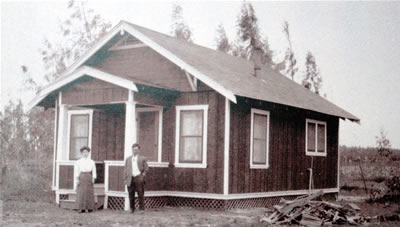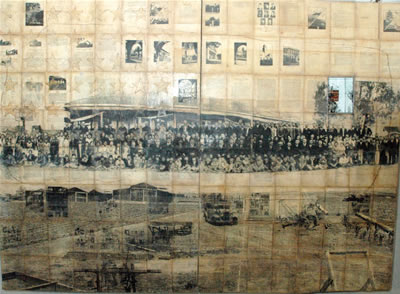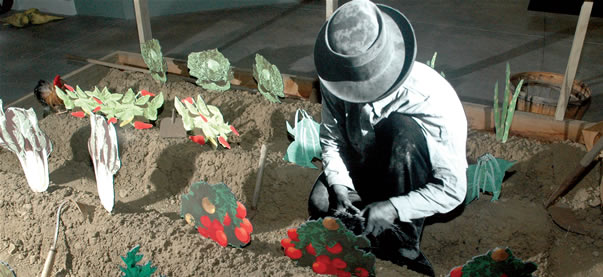Cultivating History
Fullerton Arboretum exhibit pays tribute to Japanese American farmers in Orange County
May 1, 2007
By Gail Matsunaga
Japan’s rapid movement toward modernization and industrialization during the 1870s resulted in large tax increases, high levels of poverty and a reduction of agricultural land. A decade later, the United States’ enactment of the Chinese Exclusion Act of 1882 had American farmers decrying the lack of labor and prompting thousands of Japanese farmers to emigrate to this country in search of better opportunities.
The story of those who began anew in Southern California is a significant chapter of Orange County’s agricultural history and the subject of “Sowing Dreams, Cultivating Lives: Nikkei Farmers in Pre-World War II Orange County,” the inaugural exhibit at the Fullerton Arboretum’s Orange County Agricultural and Nikkei Heritage Museum.
Inspired by the Japanese American Oral History Project Collection, “Sowing Dreams, Cultivating Lives” was curated and designed by graduate students Stephanie George and Carlota F. Haider, respectively, and showcases the contributions and experiences of the Japanese American, or Nikkei, farmers in the years before their relocation and internment in 1942.
The exhibit begins with the emigrants’ arrival in the United States through such ports as San Francisco and Seattle. A timeline and map chronicle their journey, along with photos and documents that illustrate how this first generation coped and adapted to their new home.

Mr. and Mrs. Mitsuji Furuta’s Home, Wintersburg,
c. 1912
A hands-on children’s area encourages youngsters to “pick” vegetables
out of the ground and off vines, demonstrating how some of their food is grown.
In “Forming Families,” a small kitchen scene represents the day-to-day
life of the immigrants who formed families, worked their farms and adapted to
their new country while maintaining aspects of the Japanese culture. Among the
photos and ephemera of the period are recipes — celery vinegar, Juanito’s
tamales verdes — that reflect the crops and relationships between the families
and their neighbors and coworkers.
In the 1920s, Orange County was known as the chili pepper capital of the country. “Farming
Fields” illustrates the bountiful harvests of sugar beets, cabbage and
celery that were sowed and nurtured for a growing county and country.
Unlike citrus growers who often were part of collectives that shipped their produce
to different parts of the country, Nikkei farmers engaged in truck farming, taking
their fruits and vegetables to markets the day they were picked.

One of the focal points for the exhibit is a
mixed media piece by New York artist Mike Saijo. Based on local photographs
and writings in Echo magazine — published by Orange County’s
Japanese American community prior to World War II — the work depicts
a celery farm and conveys the sense of kinship and spirit inherent among
the families.
The 7-foot-by-10-foot piece — suspended by rusted chains from a former
celery farm — was commissioned by donor and dentist Ernest Nagamatsu,
a second-generation Japanese American whose “roots” can be
traced back to a pioneering Orange County family.
“Building Communities” depicts the institutions — the churches;
political, sports and social groups; and Japanese-language schools — that
helped develop the community. A striking kendo uniform is displayed, along with
pre-World War II artifacts from a Buddhist church.
Arguably the most popular part of the exhibit, according to Haider, is a video
monitor displaying a slide show of 500 photographs. Images of families, wedding
portraits, farms, houses, sports teams, businesses, the aftermath of the 1938
flood, cars, family trips to Japan and leisure-time snapshots of beach, fishing
and hiking outings suggest the texture of ordinary life.
“The photos tell the greater and more personal story of the Nikkei community
in Orange County,” George said.
Against the backdrop of the United States’ impending involvement in World
War II, “Uprooting Lives” depicts the events leading to the internment
of Japanese Americans and the loss of their property and businesses. In stark
contrast to the rest of the exhibit, there are no photographs or faces represented.
In explaining the design of “Sowing Dreams, Cultivating Lives,” George
said: “We knew that there had been a thriving Nikkei community, but not
a lot of research was conducted. Because of our extensive Nikkei collection,
I started reading the oral histories. With the exhibit, we tried to let their
voices tell the larger story. The focus is not only on the families, but what
it was like to be a farmer. Certain themes arose: immigration, forming families,
experience as farmers and, finally, exclusion and incarceration.”
Much like the teamwork crucial to farming, bringing the exhibit together, Haider
said, involved the efforts of many people from different parts of the university,
including anthropology, history, visual arts and biology.
The exhibit is open on weekends and by appointment during the week through July
29. For more information, call 657-278-3407 or visit www.arboretum.fullerton.edu.


